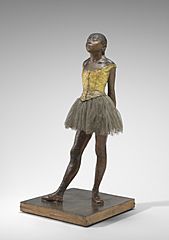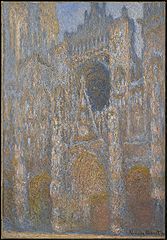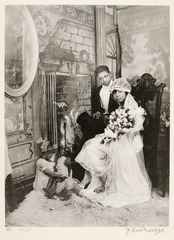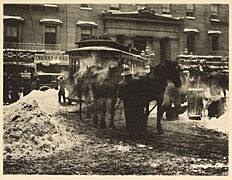Clark Art Institute facts for kids
 |
|

The Clark Art Institute
|
|
| Established | 1955 by Robert Sterling Clark and Francine Clark |
|---|---|
| Location | 225 South St, Williamstown, MA 01267 |
| Type | Art Museum, Research Institute, and Graduate Program |
| Accreditation | American Alliance of Museums |
| Architect | Pietro Belluschi, Daniel Deverell Perry, Tadao Ando, Annabelle Selldorf |
The Sterling and Francine Clark Art Institute, usually called the Clark, is an art museum and research center. It is located in Williamstown, Massachusetts, United States. The museum has a large collection of European and American art. This includes paintings, sculptures, drawings, photos, and decorative items. These artworks are from the 1300s to the early 1900s.
The Clark is one of three important art museums in the Berkshires. The others are the Massachusetts Museum of Contemporary Art (MASS MoCA) and the Williams College Museum of Art (WCMA). The Clark is also a place for learning and research. It has special programs like the Fellowship Program. It also hosts the Williams College Graduate Program in the History of Art. The Clark's library is one of the best in the country. It has over 295,000 books in more than 72 languages. About 200,000 people visit the Clark each year. It offers many fun educational programs for all ages.
Contents
History of the Clark Art Institute
The Clark Art Institute opened in 1955. It was started by Robert Sterling Clark and his wife, Francine Clark. Robert Sterling Clark was a businessman, soldier, and art collector. He inherited a lot of money from his grandfather. His grandfather was a main owner of the Singer Sewing Machine Company.
Robert Sterling Clark began collecting art after moving to Paris in 1911. Francine joined him in collecting after they married in 1919. The Clarks usually kept their art collection private. They rarely loaned out any of their artworks.
Why the Clark was Created
During the Cold War, the Clarks worried about their art. They wanted to protect their collection from a possible attack on New York City. They lived there, and the Metropolitan Museum of Art was also there. The Metropolitan Museum was supposed to receive their collection.
So, the Clarks started looking for places in the countryside. They looked in New York and Massachusetts. Their goal was to build a new museum for their art.
They visited Williamstown, Massachusetts, in 1949. They talked with town leaders and people from Williams College. Sterling Clark had family ties to Williams College. His grandfather and father had both been trustees there.
Founding the Institute
The official document to create the "Robert Sterling Clark Art Institute" was signed on March 14, 1950. It was planned to be both a museum and an educational place. Soon after, in 1953, Sterling changed the name. It became the "Sterling and Francine Clark Art Institute." He wanted to include Francine because of her "constant enthusiasm" and her help. She helped collect the art and plan the museum.
The Clark opened its doors to the public on May 17, 1955. Peter Guille, a former silver dealer, was its first director. Since then, the Clark has become a popular spot. It attracts tourists, art lovers, and scholars. It has helped make the Berkshires famous for its culture.
Architecture and Buildings
Sterling Clark wanted the museum to have lots of natural light. He also wanted it to look classic. He was not happy with early designs from other architects. So, he chose Daniel Perry. Clark suggested a design similar to the Frick Collection, but simpler.
Original Museum Building
Construction of the first building took almost two years. It cost nearly $3 million. The building opened on May 17, 1955. It even had a private apartment for the Clark family. This apartment became Sterling Clark's last home. His ashes are buried under the front steps of the building.
Newer Buildings and Updates
The Manton Research Center was finished in 1973. Pietro Belluschi designed this building. It holds the library and research programs. In 2001, the Clark started a big project to improve its campus. They worked with landscape designers Reed Hilderbrand and architects Tadao Ando and Annabelle Selldorf.
Hilderbrand redesigned the outdoor areas. They improved walking trails and planted 1,000 trees. They also created a reflecting pool that uses recycled water.
Tadao Ando designed two new buildings. The Lunder Center at Stone Hill opened in 2008. The Clark Center, which is 42,600 square feet, opened in 2014. The Lunder Center is like a quiet place in the woods. It has two art galleries and a seasonal cafe. It also houses the Williamstown Art Conservation Center. This is the largest art conservation center in the country.
The Clark Center has over 11,000 square feet of gallery space. This is for special art shows. It also has new dining areas, shops, and family spaces. A glass Museum Pavilion creates a new entrance to the original building. The Clark Center is made of stone, concrete, and glass. It is the main visitor entrance to the Clark's campus.
Annabelle Selldorf updated the older buildings. In the original 1955 marble building, new galleries were added. These are for American and decorative art. The space for art shows grew by 15%. The Manton Research Center reopened in 2016. Its auditorium and central courtyard were updated. New galleries and a study center were also created. This finished the Clark's big expansion project. The museum's $145 million expansion was paid for by donations.
Selldorf was also chosen to design the Aso O. Tavitian Wing. This new building is planned to be finished in 2027 or 2028. It will be located between the Manton Research Center and the original museum building.
Art Collection

The Clarks first collected older European paintings. These were from Italy, Holland, and Flanders. Over time, they started to like artists like John Singer Sargent, Edgar Degas, Winslow Homer, and Pierre-Auguste Renoir. After 1920, they focused mostly on French art from the 1800s. This included Impressionism and the Barbizon School. For 35 years, the Clarks added to their collection. They gathered paintings, porcelain, silver, prints, and drawings. These artworks range from the early 1300s to the early 1900s.
Highlights of the Collection
The museum's permanent collection has many famous pieces. Works by Renoir, Rodin, George Inness, John Singer Sargent, and Jean-Léon Gérôme are very important. The Clark is well-known for its French Impressionist art. It also proudly displays Nymphs and Satyr by Bouguereau. This is one of the greatest French academic artworks.
New Artworks Added
The Clark keeps adding to its collection. This helps it better achieve its goals. Recent additions include Brutus Condemning His Sons to Death by Guillaume Guillon-Lethière. They also acquired the Landscape Album (Paysage). This album has about one hundred landscape drawings, mostly by Lethière.

Another new acquisition is the Tea Service of Famous Women (Cabaret des femmes célèbres). This set was painted by Marie-Victoire Jaquotot. It is one of only three known sets. It features portraits of women famous for their achievements. These include women in government, literature, and philosophy. Other new artworks include The Swearing in of President Boyer at the Palace of Haiti by Adolphe-Eugène-Gabriel Roehn. The museum also received an important gift from Frank and Katherine Martucci. This gift includes early photographs of and by Black Americans. These photos are by Edward J. Souby and James Van Der Zee. In 2013, Frank and Katherine Martucci gave the museum eight George Inness landscapes. These joined two of his works already in the collection.
Manton Collection of British Art

The Clark Art Institute has grown its collection since 1955. It has done this through buying art, gifts, and bequests. Recently, it has focused on adding to its photography collection. In 2007, the Manton Foundation gave the museum its founders' collection. Sir Edwin and Lady Manton's collection of British Art has over 200 works. These are by British artists like J.M.W. Turner, Thomas Gainsborough, and John Constable.
Aso O. Tavitian Collection
In 2024, the Clark Art Institute received a huge gift. The Aso O. Tavitian Foundation donated 331 artworks. This included 132 paintings, 130 sculptures, and 39 drawings. There were also 30 decorative art objects. These works are by European artists like Hans Memling, Peter Paul Rubens, Parmigianino, Élisabeth Vigée Le Brun, Jean-Antoine Watteau, Gian Lorenzo Bernini, and Jan van Eyck. Aso O. Tavitian passed away in 2020. He also left the museum $45 million. This money will be used to build a new wing for the collection.
Special Exhibitions
The Clark hosts special art shows all year long. These shows cover many different topics. They feature well-known artists and also lesser-known ones. The shows include older artworks and contemporary pieces. Most special exhibitions are shown in different galleries across the campus. Some shows have traveled to other places after being at the Clark. An example is Edvard Munch: Trembling Earth.
Here are some notable exhibitions from the last 15 years:
- Guillaume Lethière, June 15-October 14, 2024
- Edvard Munch: Trembling Earth, June 10–October 15, 2023
- Promenades on Paper: Eighteenth-Century French Drawings from the Bibliothèque nationale de France, December 17, 2022–March 12, 2023
- Nikolai Astrup: Visions of Norway, June 19-September 19, 2021
- Renoir: The Body, The Senses, June 8-September 22, 2019
- Wall Power, December 14, 2024-March 9, 2025
- Pissarro’s People, June 12–October 2, 2011
- El Anatsui, June 12-October 16, 2011
- Jennifer Steinkamp: Blind Eye, June 30-October 8, 2018
- Jacques-Louis David: Empire to Exile, June 6-September 5, 2005
- Claude & François-Xavier Lalanne: Nature Transformed, May 8-October 31, 2021
- Orchestrating Elegance: Alma-Tadema and Design, June 4-September 4, 2017
- Lin May Saeed: Arrival of the Animals, July 21-October 25, 2020
You can find more information about current exhibitions on the Clark's website.
Campus and Grounds
The Clark campus covers 140 acres of land. This includes meadows, woods, and walking trails. Sterling and Francine Clark wanted visitors to enjoy the natural beauty of the Berkshires. In warmer months, visitors see a large three-tiered reflecting pool. Landscape architect Reed Hilderbrand designed this pool.
Cows at the Clark
In the warmer months, you can also see cows grazing. They are in the pastures on and above Stone Hill. The Clark Art Institute website says the cows are friendly. However, they prefer not to be approached too closely.
Project Snowshoe
During the winter, visitors can borrow snowshoes for free. This lets them explore the Clark campus and trails in the snow.
Outdoor Art Installations
The Clark campus has several outdoor art installations. Their first full outdoor exhibition was Ground/work. It ran from October 2020 to October 2021. It showed works from artists around the world. These included Nairy Baghramian, Jennie C. Jones, and Haegue Yang. This exhibition turned the campus meadows and woodlands into an outdoor gallery. It showed the Clark's growing interest in working with living artists. The second Ground/work exhibition is happening between June 2025 and October 2026. It features artists like Javier Senosiain and Hugh Hayden. Even though the first Ground/work exhibition has ended, you can still see various outdoor sculptures. These are around the campus and are free to view.
Academic Programs
Research and Academic Program

The Research and Academic Program (RAP) is a key part of the Clark. It shows the Clark's commitment to scholarly study. The program started in the late 1990s. This was when the Clark Library and the Graduate Program in the History of Art were created. The program has grown to work with institutions and scholars worldwide. It aims to expand the study of visual arts. Caroline Fowler is the Starr Director of the Research and Academic Program. She also teaches at Williams College.
The Research and Academic Program also gives out Clark Fellowships. Between ten and sixteen fellowships are awarded each year. They last from four weeks to ten months. These fellowships allow promising scholars and museum officials to do research. Fellows, scholars, and students from all over the world can join. They are encouraged to take part in conferences, workshops, and seminars.
The Clark also publishes books like The Clark Studies in the Visual Arts. These books are based on the annual Clark Conferences. They explore art history topics from different fields. You can also listen to the Research and Academic Program podcast. It is called In the Foreground: Conversations on Art & Writing. This podcast offers a deep look into the lives of scholars and artists.
Williams College Graduate Program in the History of Art
The Williams College Graduate Program in the History of Art started in 1972. It works with the Clark. This is an intense two-year program. It combines schoolwork, museum internships, and workshops. It also includes an international study tour. Students learn from many different teachers. They earn a Master of Arts degree in art history. The program is on the Clark Campus. It uses the art history resources of both institutions. Almost 1,500 people have graduated from this program. Famous alumni include Sasha Suda, director of the Philadelphia Museum of Art. Also, James Rondeau, director of the Art Institute of Chicago, is an alumnus.
Clark Prize for Excellence in Arts Writing

The Clark Prize for Excellence in Arts Writing has been given out every other year since 2006. This prize honors writing that is insightful and easy to understand. It helps people truly understand and appreciate visual arts. The award is for writing that explains complex ideas. It must be based on good research but also appeal to many different people.
In 2006, three people received the award. After that, one person was chosen each time. In 2022, there were two winners because of the pandemic.
Winners of the Prize include:
- 2006: Kobena Mercer, Linda Nochlin and Calvin Tomkins
- 2008: Peter Schjeldahl
- 2010: Hal Foster
- 2012: Brian O'Doherty
- 2015: Eileen Myles
- 2017: Darcy Grimaldo Grigsby
- 2022: Hilton Als and Helen Molesworth
- 2024: Bénédicte Savoy
Library

The Clark library opened in 1962. It is one of the most important art reference libraries in the United States. The library has over 280,000 books. It also has many special collections. These include Robert Sterling Clark's rare books. The materials include standard art reference books and databases. There are also scholarly journals in 65 languages from over 140 countries. The library also has exhibition catalogs and museum publications. It has many auction catalogs from the 1800s and early 1900s. The library is open to everyone, and admission is free.
Directors
- Peter Guille (1955–1966)
- George Heard Hamilton (1966–1977)
- David Brooke (1977–1994)
- Michael Conforti (1994–2016)
- Olivier Meslay (2016–present)
Works in The Permanent Collection
-
Mary Cassatt, Offering the Panal to the Bullfighter, 1873 [3]
-
James Van Der Zee, Wedding Day, Harlem, 1926, printed 1974, gelatin silver print. Gift of Frank and Katherine Martucci [4]
-
Piero della Francesca, Virgin and Child Enthroned with Four Angels, c. 1460–70 [6]
-
Jean-Léon Gérôme, Snake Charmer, c. 1879, oil on canvas [8]
-
George Inness, Home at Montclair, 1892, oil on canvas [10]
-
Joseph Mallord William Turner, Rockets and Blue Lights (Close at Hand) to Warn Steamboats of Shoal Water, 1840, oil on canvas [11]
-
Frederic Remington, Dismounted: The Fourth Troopers Moving the Led Horses, 1890, oil on canvas.
-
Alfred Stieglitz, The Terminal, 1893; printed c. 1910, gift of Penelope Tyson Adams in memory of husband, John Barclay Adams [12]
See also
 In Spanish: Instituto de Arte Clark para niños
In Spanish: Instituto de Arte Clark para niños


















